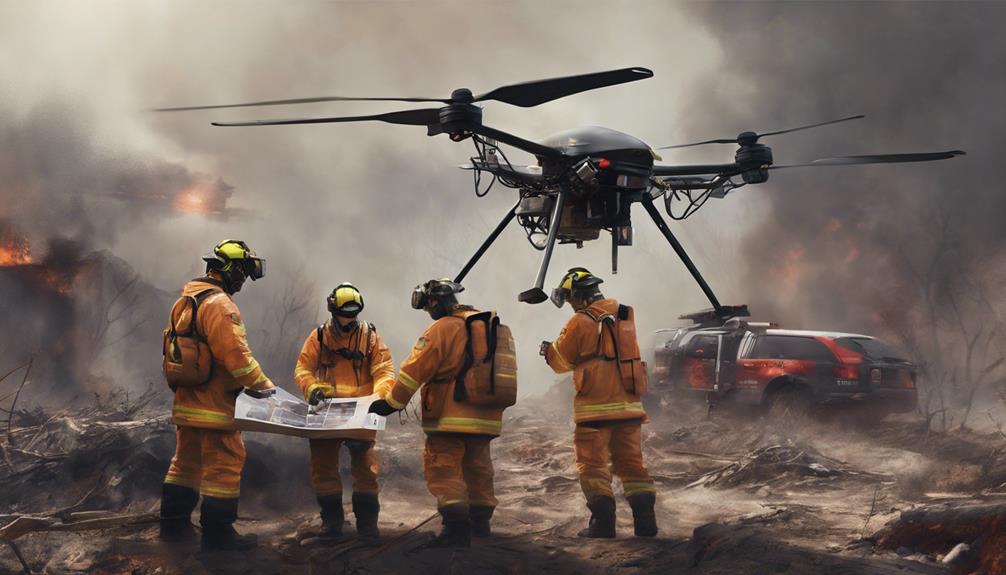In the realm of disaster response, the ability of rescue teams to swiftly and effectively locate individuals in distress is paramount. Employing a blend of strategic methodologies and cutting-edge technologies, these teams navigate the challenging terrain of disaster zones with precision and determination. From utilizing drones for aerial reconnaissance to harnessing the sensory acuity of search dogs, the arsenal of tools at their disposal is as diverse as it is innovative. Yet, amidst the complexity of these operations lies a fascinating confluence of science, skill, and unwavering dedication that underscores the unwritten story of how lives are saved in the face of adversity.
Key Takeaways
- Rescue teams utilize drones with thermal imaging to detect heat signatures of survivors.
- Specialized tools like sonar technology and search cameras aid in locating individuals under debris.
- Helicopter rescue operations equipped with hoists reach remote areas for timely evacuations.
- Integration of AI algorithms and GPS tracking systems optimize search efforts in disaster scenarios.
Wide Area Assessment Techniques
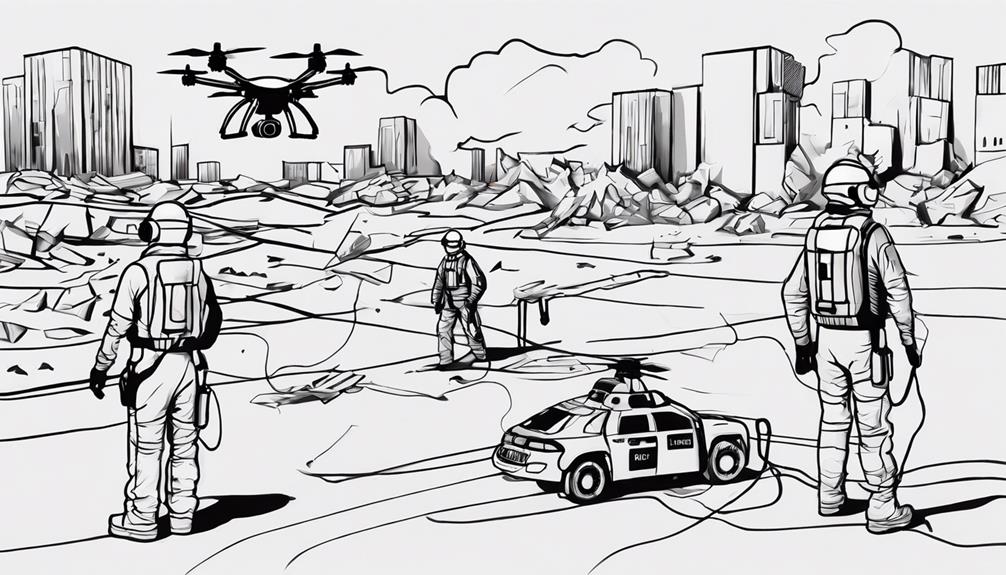
Local emergency response teams employ wide area assessment techniques to systematically evaluate resources, hazards, and priorities within disaster zones. These assessments are crucial in efficiently managing search and rescue operations. Preliminary surveys are conducted to divide the disaster area into sectors, allowing for more organized command structures and optimized search team deployments. Worksite triage plays a vital role in assessing viable rescue sites by prioritizing areas based on information gathered from locals regarding collapsed structures.
Furthermore, specially trained dogs are utilized to rapidly detect signs of life, aiding in the swift assessment of disaster sites. These animals play a critical role in identifying potential survivors in the rubble. Additionally, rescuers meticulously document void spaces, building materials, and hazards to categorize different types of building collapse and gauge structural integrity during search and rescue operations. This detailed information guides responders in making informed decisions and ensuring the safety of both rescuers and survivors.
Utilization of Drones in Searches
The integration of drones in search and rescue operations revolutionizes disaster response efforts by providing crucial real-time data for identifying and locating survivors in challenging environments. Drones equipped with thermal imaging cameras can detect heat signatures of survivors, aiding in swift location and survivors detection in disaster zones. Through aerial reconnaissance, drones assist search and rescue teams in identifying individuals in hard-to-reach areas, where traditional methods may fall short. The real-time visual data provided by drones is instrumental in surveying disaster sites and facilitating the rapid location of people in need of rescue. The thermal imaging technology on drones enables search teams to spot survivors amidst rubble and debris, increasing the efficiency and effectiveness of the search and rescue missions. Overall, the utilization of drones in searches enhances the capabilities of rescue teams, improving their ability to locate and save individuals in perilous situations.
Advanced Sonar Technology for Location
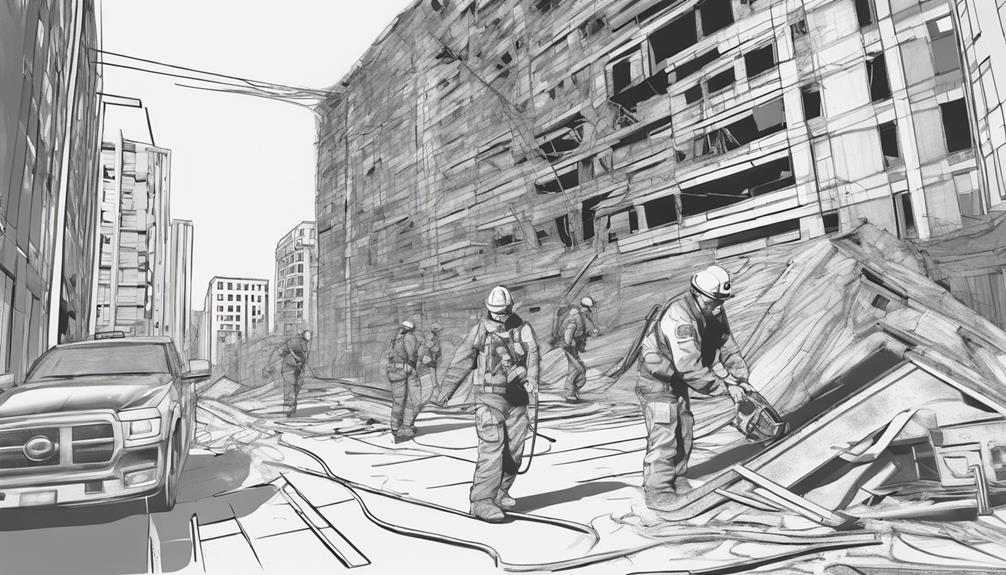
Integration of advanced sonar technology enhances search and rescue operations by utilizing sound waves to detect and locate survivors in disaster scenarios, complementing the capabilities of drones in identifying individuals in need of rescue. Sonar technology plays a crucial role in locating survivors trapped under rubble by penetrating debris and detecting even faint sounds or movements. This advanced technology enables search and rescue teams to pinpoint the exact locations of survivors, aiding in efficient extraction efforts.
Key Points:
- Sonar devices can penetrate debris and detect faint sounds or movements of trapped individuals.
- Sonar technology helps pinpoint the exact locations of survivors for efficient extraction.
- Crucial in identifying void spaces where survivors may be trapped, aiding in targeted rescue efforts.
Thermal Imaging for Detection
Thermal imaging technology plays a crucial role in disaster response efforts by enabling the detection of heat signatures from individuals in distress. Its night vision capabilities allow rescuers to locate survivors in low-light conditions, significantly improving search operations during darkness. By penetrating obstacles like smoke and dust, thermal imaging enhances the efficiency of search and rescue missions by pinpointing areas where survivors are most likely to be found.
Heat Signatures Detection
Utilizing advanced thermal imaging technology revolutionizes the search and rescue process by enabling the precise detection of heat signatures emitted by individuals trapped in disaster scenarios.
- Thermal imaging technology detects heat signatures emitted by trapped individuals under rubble.
- Rescuers use thermal cameras to locate survivors based on variations in body temperature.
- Heat detection aids in identifying individuals who may not be visible to the naked eye.
This method proves invaluable in challenging environments, where traditional search methods may fall short. By leveraging thermal imaging for detection, search and rescue teams can swiftly and accurately locate individuals in need of assistance, significantly improving the outcomes of rescue operations.
Night Vision Capabilities
Night vision capabilities through thermal imaging technology significantly enhance the effectiveness of search and rescue operations by enabling the detection of body heat signatures in dark or obscured environments during disaster scenarios. Infrared cameras, a key component of thermal imaging technology, can identify individuals not visible to the naked eye, aiding in locating survivors in low-light conditions. This technology provides real-time visuals of heat patterns, allowing rescuers to pinpoint human presence beneath rubble or in hidden spaces. By utilizing thermal imaging devices, rescue teams can detect human body temperatures even in adverse conditions, improving the efficiency and effectiveness of locating and rescuing individuals by identifying their thermal signatures.
Searching in Darkness
The advancement of technology in detecting body heat signatures has revolutionized search and rescue operations, particularly in navigating darkness to locate individuals in disaster situations.
- Thermal imaging technology enables the detection of body heat signatures in low light conditions.
- Rescuers utilize thermal cameras to identify human body temperatures even through obstacles like smoke or debris.
- This technology aids in pinpointing the presence of survivors trapped in collapsed structures based on their thermal signatures.
Search Dogs and Their Role
Specially trained search dogs play a crucial role in disaster response efforts by swiftly covering vast areas and utilizing their acute sense of smell to locate individuals in distress. These highly trained canines, known as search and rescue dogs, are essential in detecting signs of life, such as breathing or movement, in challenging environments like collapsed buildings or remote disaster sites. Trained dogs work alongside international search and rescue teams, providing rapid detection capabilities that aid in the location of survivors. Their keen sense of smell allows them to pinpoint the exact location of individuals, even in hard-to-reach or inaccessible areas, complementing the efforts of human rescuers. The use of canine units significantly enhances the efficiency of search and rescue operations, increasing the chances of finding and saving lives in disaster scenarios. Through their specialized training and innate abilities, search dogs serve as invaluable assets in disaster response missions worldwide.
GPS Tracking in Rescue Missions
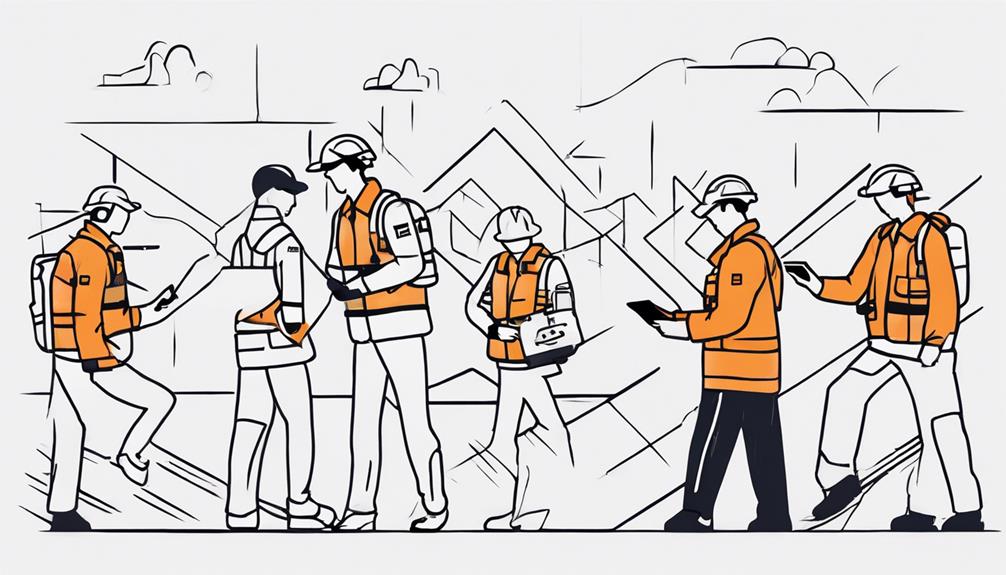
Incorporating GPS tracking systems into rescue missions revolutionizes the operational efficiency and safety protocols of search and rescue teams in disaster response scenarios.
- GPS tracking systems provide real-time location monitoring of rescue personnel, enabling teams to track their movements and positions accurately in disaster areas.
- These systems facilitate efficient resource allocation among different rescue teams, ensuring coordination and optimal use of available resources.
- GPS technology enhances situational awareness by providing crucial information about the surroundings, aiding in decision-making processes and improving overall safety measures during rescue operations.
Furthermore, GPS tracking plays a vital role in the effective deployment and navigation of rescue teams in challenging disaster scenarios. By utilizing GPS devices, rescue teams can navigate through complex terrains, locate survivors swiftly, and streamline their operations with precision. Overall, the integration of GPS tracking systems significantly enhances the effectiveness and success rates of search and rescue missions in disaster situations.
Importance of Communication Systems
Facilitating seamless communication between rescue teams and command centers is paramount in ensuring effective coordination and exchange of critical information during disaster response operations. Communication systems play a vital role in enabling real-time collaboration among rescue teams, allowing for the swift sharing of survivor locations, hazards, and resource needs. Tools such as radios, satellite phones, and drones are instrumental in maintaining connectivity and enhancing situational awareness during search and rescue missions. By integrating GPS tracking and GIS mapping technology into these communication systems, rescue operations can be conducted with improved efficiency and safety. The ability to communicate swiftly and accurately not only aids in decision-making but also ensures that resources are allocated effectively in dynamic disaster scenarios. In essence, reliable communication systems are the backbone of successful rescue missions, enabling rescue teams to work cohesively towards saving lives and mitigating the impact of disasters.
Tools for Structural Collapse Scenarios
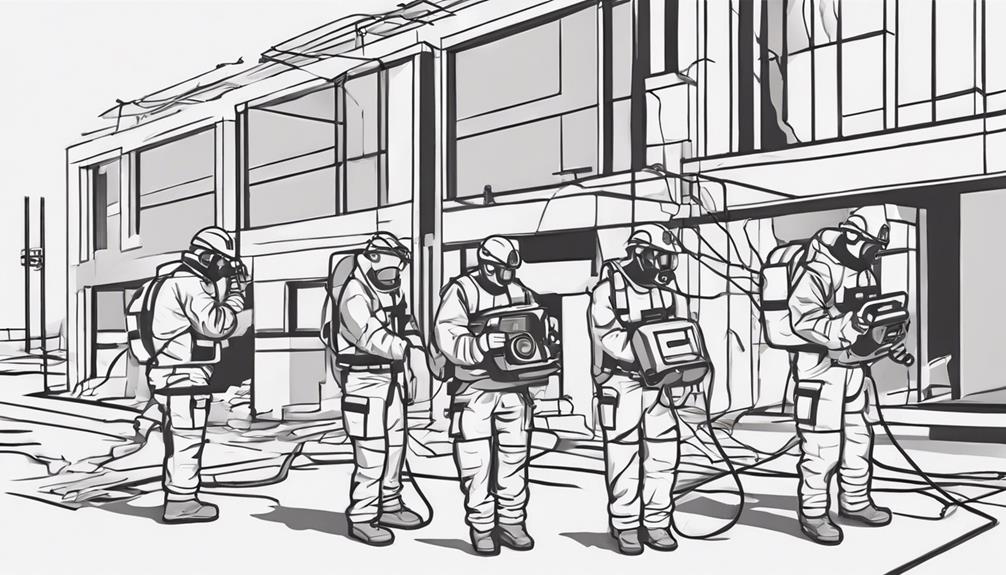
Utilizing advanced technological tools is essential for enhancing the efficiency and effectiveness of search and rescue operations in structural collapse scenarios. In such high-stress environments, the following tools play a crucial role in locating and rescuing individuals:
- Seismic Sensors: These sensors detect vibrations in collapsed structures, helping pinpoint the locations of trapped victims.
- Thermal Imaging Search Camera: Specialized cameras with thermal imaging capabilities detect body heat signatures in rubble, aiding in the identification of survivors.
- Ultra-Wide Band Radar: Utilized to detect buried victims' movements with high sensitivity, even in dense materials like concrete.
These tools, along with acoustic detection devices, specialized search cameras, and vibration detection equipment, form the backbone of search and rescue operations in structural collapse scenarios. The integration of technologies like the Leader Multisearch System, which combines various sensors and cameras for comprehensive search capabilities, ensures a systematic and efficient approach to locating and rescuing individuals in challenging disaster situations.
Medical Triage in Disaster Zones
In disaster zones, medical triage plays a critical role in swiftly assessing patients, determining the severity of their conditions, and prioritizing treatment based on the level of need. This process ensures that limited medical resources are allocated efficiently to maximize the number of lives saved. By categorizing patients according to their medical urgency, triage teams can provide immediate care to those in critical condition while also attending to the needs of less severe cases in a systematic manner.
Immediate Medical Assessment
In disaster zones, immediate medical assessment through efficient triage processes plays a vital role in prioritizing and delivering timely care to individuals based on the severity of their injuries. Triage teams quickly evaluate victims to determine who needs urgent care first. Medical personnel categorize patients into red (urgent), yellow (delayed), green (minor), and black (deceased) categories. This categorization helps allocate limited medical resources effectively in chaotic disaster environments. Proper medical triage ensures that critical patients receive timely care, increasing their chances of better survival outcomes.
Severity Level Determination
Following the immediate medical assessment conducted in disaster zones, the next critical step involves determining the severity levels of victims through medical triage processes. Triage systems prioritize treatment based on victims' medical needs and chances of survival, guiding the allocation of scarce medical resources effectively. Victims are assessed using vital signs, injuries, and overall condition to categorize them into levels such as immediate, delayed, minimal, and expectant, aiding rescue efforts. Medical personnel utilize triage tags to label and track patients, ensuring timely and appropriate care in challenging disaster settings.
| Triage Level | Description |
|---|---|
| Immediate | Requires urgent treatment |
| Delayed | Can wait for medical care |
| Minimal | Minor injuries/conditions |
| Expectant | Grave injuries, low survival |
Treatment Prioritization
Treatment prioritization in disaster zones, guided by medical triage principles, hinges on swiftly assessing and categorizing victims based on the severity of their injuries and their chances of survival.
- Triage categories include immediate, delayed, minimal, and expectant, guiding rescue teams on who to treat first.
- Resources are allocated efficiently by focusing on treating those with the highest chance of survival and critical injuries.
- Triage tags or color-coded systems help categorize patients quickly and effectively during chaotic situations.
Utilizing Robotic Search Devices
By leveraging advanced robotic search devices, such as drones equipped with cameras and sensors, rescue teams can efficiently survey disaster areas from above, significantly enhancing their ability to locate survivors and assess the extent of damage. These drones provide real-time aerial reconnaissance, enabling them to identify survivors' locations and evaluate the situation quickly. The use of drones in search and rescue operations allows access to hard-to-reach or unsafe areas, aiding rescuers in planning their interventions effectively. Furthermore, the thermal imaging capabilities of drones are instrumental in detecting heat signatures, which can be crucial in locating survivors, especially in challenging conditions such as night-time or low-visibility scenarios. Overall, robotic search devices play a vital role in enhancing the efficiency and safety of search and rescue missions during disasters, offering a technological edge that complements traditional methods and significantly improves the chances of locating and saving lives in critical situations.
Training for Swift Response
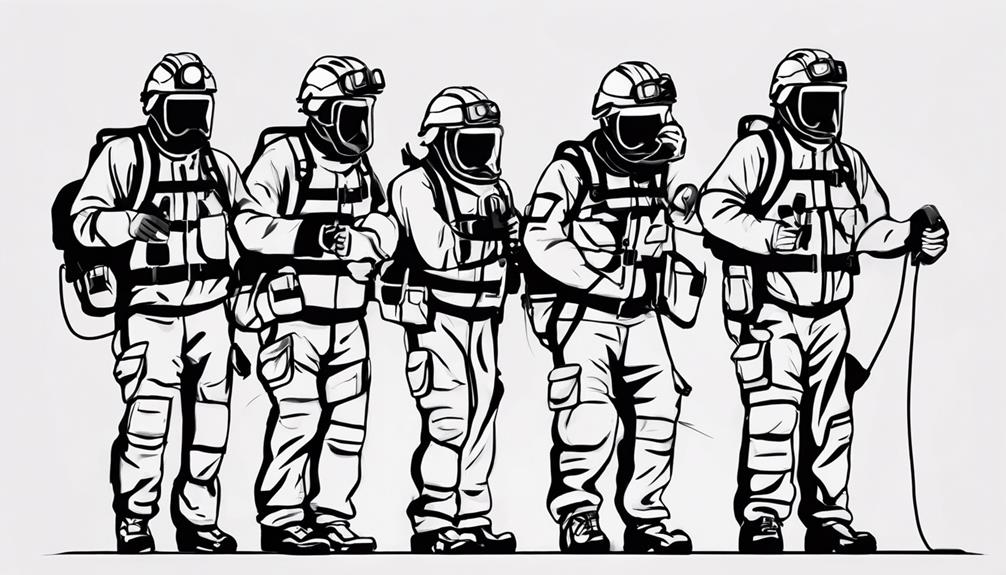
Specialized training equips search and rescue teams with the essential skills needed for swift and effective response in disaster scenarios, emphasizing rapid assessment, search techniques, and utilization of specialized equipment. Search and rescue teams undergo rigorous training to prepare for various disaster situations. This training includes:
- Coordination: Teams practice coordination, communication, and decision-making under high-pressure scenarios to ensure seamless operations during emergencies.
- Continuous Training: Continuous training is essential for rescue teams to stay updated on the latest techniques and maintain readiness for effective response in dynamic environments.
- Skill Refinement: Simulated drills and real-life simulations play a crucial role in honing skills, allowing teams to efficiently locate and rescue individuals in disasters.
Helicopter Rescue Operations
Helicopter rescue operations serve as a critical component in swiftly reaching and assisting individuals in remote or inaccessible disaster-stricken areas. Equipped with hoists and medical supplies, these helicopters can airlift injured persons to safety, enhancing the effectiveness of search and rescue attempts. Additionally, they are utilized for aerial reconnaissance, enabling teams to assess the extent of damage and locate survivors efficiently. Specialized rescue helicopters are instrumental in conducting these missions, staffed with trained personnel well-versed in utilizing USAR equipment. These operations play a pivotal role in evacuating people from hazardous or hard-to-reach locations during disasters, ensuring timely and effective assistance to those in need. The combination of skilled crews, specialized equipment, and strategic utilization of resources makes helicopter rescue operations a vital aspect of disaster response efforts, facilitating the swift and safe extraction of individuals from perilous situations.
Utilization of Underwater Search Teams
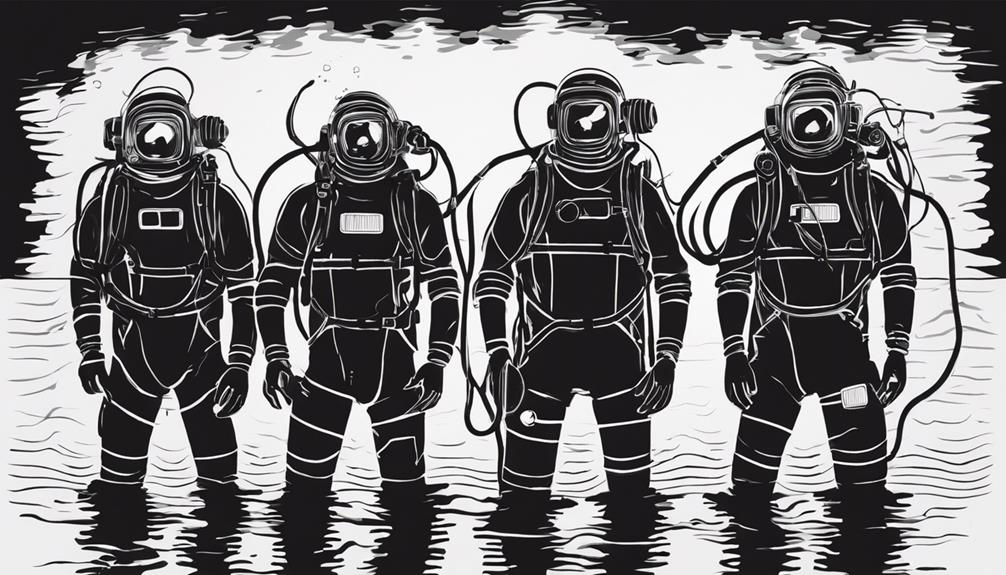
In disaster response operations, the utilization of underwater search teams emerges as a critical and specialized component for locating and rescuing individuals in submerged or flooded environments. These teams employ advanced diving equipment, sonar devices, and underwater cameras to search for and recover victims in challenging underwater environments. They work closely with surface teams and are capable of operating in rivers, lakes, oceans, and other water bodies affected by disasters.
- Divers in these teams undergo rigorous training in swift water rescue, deep diving, and underwater navigation to effectively carry out search and rescue missions.
- Utilizing specialized techniques and protocols, underwater search teams play a crucial role in locating and extricating individuals trapped or stranded in underwater disasters.
- The coordination between underwater search teams and surface teams enhances the efficiency and effectiveness of search and rescue operations in submerged areas.
Psychological Support for Survivors
Addressing the psychological well-being of survivors in disaster situations is a crucial aspect of providing comprehensive support during the aftermath. Psychological support focuses on helping survivors navigate trauma, anxiety, and emotional distress resulting from the disaster. Trained counselors and mental health professionals play a vital role in offering crisis intervention and emotional support to survivors in need. Support services often include debriefing sessions, individual or group counseling, and referrals to specialized mental health resources for ongoing assistance. Providing a safe space for survivors to express their emotions and process the impact of the disaster is essential for their recovery.
| Psychological Support Strategies | Description | Benefits |
|---|---|---|
| Debriefing sessions | Structured discussions post-event | Helps process emotions and share experiences |
| Counseling | Individual or group therapy sessions | Offers personalized support and coping strategies |
| Referrals to mental health resources | Connecting survivors with specialized help | Ensures long-term mental health support and care |
Integration of AI in Search Efforts
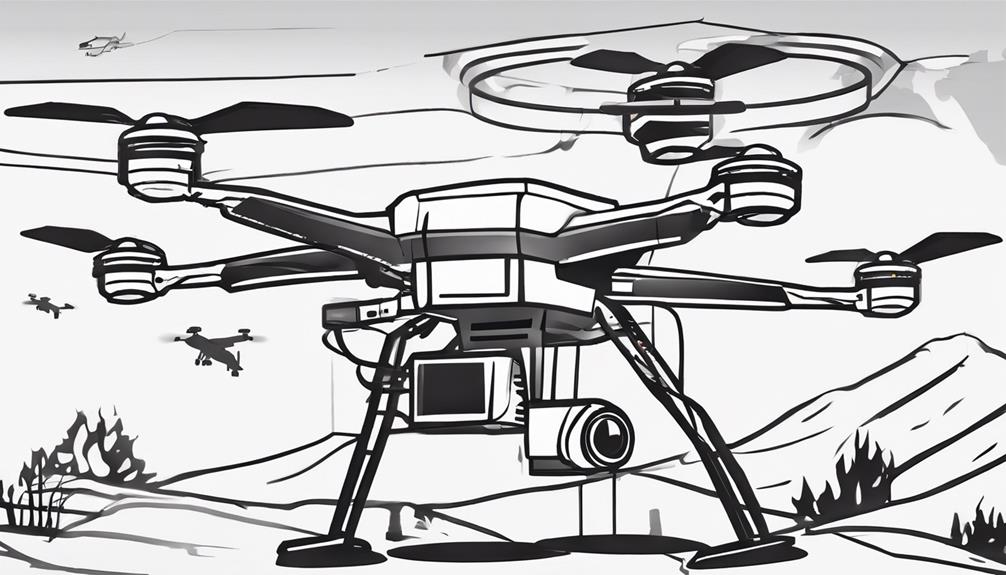
The integration of AI in search efforts revolutionizes disaster response by harnessing AI algorithms for analyzing drone and sensor data to detect signs of survivors efficiently. Machine learning models play a crucial role in processing immense datasets to prioritize search areas with the highest probability of finding individuals in need. AI-powered systems offer rapid scanning capabilities, enhancing search and rescue operations by providing real-time insights for guiding teams effectively.
Ai-Enhanced Drone Surveillance
Utilizing advanced algorithms, AI-enhanced drones play a crucial role in disaster response efforts by analyzing thermal imaging data to detect heat signatures of survivors in affected areas.
- These drones can cover large areas quickly, providing real-time information to rescue teams about potential survivors.
- Integration of AI in drone surveillance enhances search efficiency by identifying human presence amidst debris and collapsed structures.
- AI algorithms help drones differentiate between human body heat and environmental heat sources, improving accuracy in survivor detection.
Machine Learning Algorithms
Incorporating machine learning algorithms into search efforts during disaster response operations revolutionizes the efficiency and precision of locating individuals in critical situations. AI systems analyze data from drones, sensors, and cameras to identify patterns indicating human presence, enabling the pinpointing of potential survivor locations through heat signatures, movements, and sounds. By prioritizing areas with higher probabilities of finding survivors based on advanced data analysis, artificial intelligence enhances search efficiency. Machine learning models continuously adapt and improve, refining search strategies to increase accuracy in locating individuals in complex disaster scenarios. Leveraging AI technology allows rescue teams to optimize resource allocation, minimize response time, and significantly enhance the chances of successfully finding and rescuing people in disasters.
Data Analysis Efficiency
Enhancing search efficiency through the integration of AI in search efforts revolutionizes data analysis efficiency during disaster response operations.
- AI algorithms analyze seismic data to pinpoint survivor locations accurately and expedite rescue efforts.
- Integration of AI in drones enhances aerial reconnaissance capabilities for identifying survivors in disaster zones.
- Machine learning models process thermal imaging data to detect heat signatures of trapped individuals under rubble.
Frequently Asked Questions
What Methods Do Rescuers Use to Find Survivors?
Rescuers employ a variety of advanced methods to locate survivors in disaster situations. Drone technology, featuring thermal imaging, aids in identifying heat signatures in inaccessible areas. Canine units are utilized to detect human scent in rubble, while GPS tracking assists in pinpointing locations. Sonar equipment helps detect movements, and helicopter support enhances rapid response. Communication devices play a crucial role in coordinating search efforts for efficient survivor retrieval.
How Do Search and Rescue Teams Find People?
In the realm of search and rescue operations, various advanced technology tools are employed to locate individuals in distress. These include drone surveillance for aerial reconnaissance, canine teams trained in scent detection, thermal imaging cameras for heat signature identification, satellite tracking for remote monitoring, helicopter support for rapid transportation, and ground search methods for meticulous exploration. The integration of these diverse techniques enhances the efficiency and effectiveness of search and rescue missions.
How Do Search and Rescue Teams Work?
In understanding how search and rescue teams operate, it is essential to recognize the diverse tools and techniques they employ. Aerial drones, ground searchers, K9 units, thermal imaging, GPS tracking, sonar technology, and helicopter rescue missions are key components of their operations. These resources are strategically utilized to optimize search efforts, enhance efficiency, and increase the chances of successfully locating and rescuing individuals in various disaster scenarios.
What Is the Role of Search and Rescue Team During a Disaster?
During a disaster, search and rescue teams play a crucial role in emergency response, disaster relief, and rescue missions. Their focus is on providing humanitarian aid, employing survival techniques, coordinating team efforts, and managing crises effectively. These specialized teams are trained to navigate challenging environments, assess risks, and prioritize search areas to maximize the chances of locating and rescuing survivors in a timely manner.
Conclusion
In conclusion, "Where there's a will, there's a way." Rescue teams employ a variety of advanced techniques and technologies to locate individuals in disaster situations efficiently. From wide area assessments to the utilization of drones, sonar technology, thermal imaging, search dogs, and helicopter rescue operations, these teams demonstrate a relentless dedication to saving lives. By integrating AI and providing psychological support to survivors, rescue teams continue to be at the forefront of disaster response efforts.
